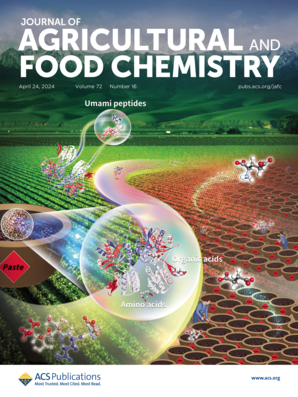纳米硒与亚硒酸盐肥料:对毒理学、抗氧化防御和铁死亡途径的影响
IF 5.7
1区 农林科学
Q1 AGRICULTURE, MULTIDISCIPLINARY
引用次数: 0
摘要
叶面肥料硒能提高作物营养,解决人体硒缺乏问题,但施用不当可能导致过量摄入和残留积累。我们的研究在细胞、斑马鱼和小鼠模型上全面评估了新型纳米硒和传统亚硒酸钠肥料的毒性和功能。两种肥料在低剂量时均增强了抗氧化途径,但纳米硒在高剂量时表现出更强的抗氧化和调控铁中毒作用,且毒性较低。亚硒酸钠增加了总ROS和脂质ROS的产生,导致细胞活力下降,增加了斑马鱼的畸变和死亡率。在小鼠中,亚硒酸钠诱导肝毒性并降低GPX4。转录组分析显示,亚硒酸钠下调c-JUN和APOA4,削弱抗氧化防御,而硒纳米颗粒通过FGF21促进铁下沉抗性。这些发现表明,硒纳米颗粒作为硒生物强化的一种更安全的替代品,可以减轻健康风险,同时支持粮食安全和环境可持续性。本文章由计算机程序翻译,如有差异,请以英文原文为准。

Selenium Nanoparticles vs Selenite Fertilizers: Implications for Toxicological Profiles, Antioxidant Defense, and Ferroptosis Pathways
Selenium (Se) foliar fertilizers enhance crop nutrition and address human selenium deficiency, while improper application may lead to excessive intake and residue accumulation. Our study comprehensively assessed the toxicity and function of novel selenium nanoparticles and traditional sodium selenite fertilizers across cell, zebrafish, and murine models. Both fertilizers enhanced antioxidant pathways at low doses, but selenium nanoparticles exhibited stronger antioxidant and ferroptosis-modulating effects with lower toxicity at a high dose. Sodium selenite increased total and lipid ROS production, leading to decreased viability of cells and increased distortion and mortality of zebrafish. In mice, sodium selenite induced hepatic toxicity and decreased GPX4. Transcriptome analysis revealed that sodium selenite downregulated c-JUN and APOA4, weakening the antioxidant defense, whereas selenium nanoparticles promoted ferroptosis resistance through FGF21. These findings suggest selenium nanoparticles as a safer alternative for Se biofortification, mitigating health risks while supporting food security and environmental sustainability.
求助全文
通过发布文献求助,成功后即可免费获取论文全文。
去求助
来源期刊
CiteScore
9.90
自引率
8.20%
发文量
1375
审稿时长
2.3 months
期刊介绍:
The Journal of Agricultural and Food Chemistry publishes high-quality, cutting edge original research representing complete studies and research advances dealing with the chemistry and biochemistry of agriculture and food. The Journal also encourages papers with chemistry and/or biochemistry as a major component combined with biological/sensory/nutritional/toxicological evaluation related to agriculture and/or food.

 求助内容:
求助内容: 应助结果提醒方式:
应助结果提醒方式:


